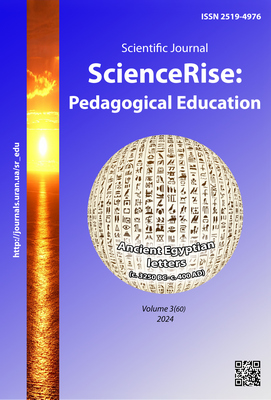Explanation of the problem of pulmonary embolism in relation to the optimization of modern algorithms for the actions of the family doctor
DOI:
https://doi.org/10.15587/2519-4984.2024.310652Keywords:
teaching, educational process, pulmonary embolism, action algorithm, family doctorAbstract
The purpose of the work is to ensure the improvement of the quality of education and educational services at a level that meets the expectations and needs of the family doctor, contributes to the optimization of the educational process on the problem of pulmonary embolism.
Determination of clinical probability is an important component of management of patients with suspected PE. In clinical practice, the Canadian (P.S. Wells) and Geneva scales are most often used for this. For a patient with a high clinical probability of PE, multispiral computer tomography (MSCT) is of primary importance. With suspected high-risk PE, evidenced by shock or hypotension, CT angiography or bedside transthoracic echocardiography should be performed for diagnostic purposes. Today, magnetic resonance imaging is not recommended for the diagnosis of PE. Outpatient treatment should be carried out with PESI class I-II. Inpatient treatment - with PESI III-V class. Anticoagulant therapy (ACT), which should be started as early as possible at the stage of diagnosis, is the basis of VE treatment. Thrombolytic therapy should be carried out in the clinic of shock or in the presence of hemodynamic instability.
As a basis for planning the educational process, it is desirable to take the constructive alignment model, which consists of the following three logically interconnected components. First of all, these are learning outcomes that must be aligned with the goals of the curriculum. Secondly, educational activities should be related to expected learning outcomes. An important component is assessment and feedback.
The professional training of a general practitioner - a family doctor is aimed at acquiring new knowledge, deepening professional competences and improving practical skills to maintain an appropriate level of training for today's urgent problem - pulmonary embolism, taking into account the realities of wartime and the threat of repeated outbreaks of covid infection (CI)
References
- Wendelboe, A. M., Raskob, G. E. (2016). Global Burden of Thrombosis. Circulation Research, 118 (9), 1340–1347. https://doi.org/10.1161/circresaha.115.306841
- Agnelli, G., Anderson, F., Arcelus, J., Bergqvist, D., Brecht, J., Greer, I. et al. (2007). Venous thromboembolism (VTE) in Europe. Thrombosis and Haemostasis, 98 (10), 756–764. https://doi.org/10.1160/th07-03-0212
- Konstantinides, S. V., Meyer, G., Becattini, C., Bueno, H., Geersing, G.-J., Harjola, V.-P. et al. (2019). 2019 ESC Guidelines for the diagnosis and management of acute pulmonary embolism developed in collaboration with the European Respiratory Society (ERS). European Respiratory Journal, 54 (3), 1901647. https://doi.org/10.1183/13993003.01647-2019
- Kostiushko, Yu. O. (2015). Obgruntuvannia modeli konstruktyvnoi mizhosobystisnoi vzaiemodii. Problemy osvity, 85, 73–79.
- Willison, J., Zhu, X., Xie, B., Yu, X., Chen, J., Zhang, D., Shashoug, I. et al. (2020). Graduates’ affective transfer of research skills and evidence based practice from university to employment in clinics. BMC Medical Education, 20 (1). https://doi.org/10.1186/s12909-020-1988-x
- Orban, K., Ekelin, M., Edgren, G., Sandgren, O., Hovbrandt, P., Persson, E. K. (2017). Monitoring progression of clinical reasoning skills during health sciences education using the case method – a qualitative observational study. BMC Medical Education, 17(1). https://doi.org/10.1186/s12909-017-1002-4
- Rodríguez, G., Pérez, N., Núñez, G., Baños, J.-E., Carrió, M. (2019). Developing creative and research skills through an open and interprofessional inquiry-based learning course. BMC Medical Education, 19 (1). https://doi.org/10.1186/s12909-019-1563-5
- Haugland, M. J., Rosenberg, I., Aasekjær, K. (2022). Collaborative learning in small groups in an online course – a case study. BMC Medical Education, 22 (1). https://doi.org/10.1186/s12909-022-03232-x
- Lillevang, G., Ibsen, H., Prins, S. H., Kjaer, N. K. (2020). How to enhance and assess reflection in specialist training: a mixed method validation study of a new tool for global assessment of reflection ability. BMC Medical Education, 20 (1). https://doi.org/10.1186/s12909-020-02256-5
- Zhang, Z., Hu, Q., Xu, C., Zhou, J., Li, J. (2022). Medical teachers’ affective domain teaching dilemma and path exploration: a cross-sectional study. BMC Medical Education, 22 (1). https://doi.org/10.1186/s12909-022-03870-1
- Kim, K.-J., Kim, S. R., Lee, J., Moon, J.-Y., Lee, S.-H., Shin, S. J. (2022). Virtual conference participant’s perceptions of its effectiveness and future projections. BMC Medical Education, 22 (1). https://doi.org/10.1186/s12909-021-03040-9
- Harrison, C. J., Könings, K. D., Schuwirth, L. W. T., Wass, V., van der Vleuten, C. P. M. (2017). Changing the culture of assessment: the dominance of the summative assessment paradigm. BMC Medical Education, 17 (1). https://doi.org/10.1186/s12909-017-0912-5
Downloads
Published
How to Cite
Issue
Section
License
Copyright (c) 2024 Svitlana Sheyko

This work is licensed under a Creative Commons Attribution 4.0 International License.
Our journal abides by the Creative Commons CC BY copyright rights and permissions for open access journals.
Authors, who are published in this journal, agree to the following conditions:
1. The authors reserve the right to authorship of the work and pass the first publication right of this work to the journal under the terms of a Creative Commons CC BY, which allows others to freely distribute the published research with the obligatory reference to the authors of the original work and the first publication of the work in this journal.
2. The authors have the right to conclude separate supplement agreements that relate to non-exclusive work distribution in the form in which it has been published by the journal (for example, to upload the work to the online storage of the journal or publish it as part of a monograph), provided that the reference to the first publication of the work in this journal is included.








